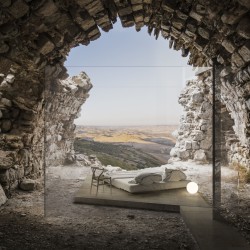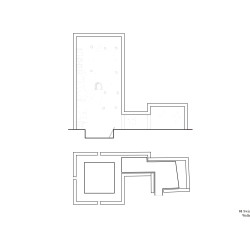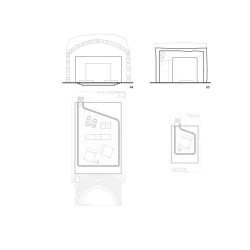Joan Maravilla Toldrà . Pau Olmo Ciges . Sergio Llobregat Ruiz
Beyond understanding the shelter as an object, the project acts in Craco globally. The intervention lays on the ruins a continuous pavement that connects the shelters and articulates a new urban contemporary structure. As if it were an infinite carpet, the new ground floor plan dilates public space and, through the lookout viewpoints, dilutes it in the landscape.
This lattice of continuos pavement, is made and built with the stone remains that lie in the hills. In this way, the degraded buildings become such as “operational ruins”, and therefore becoming a useful resource to generate architectural intervention.” The public program is decentralized, spreading along Craco to force it through it, strategically occupying the milestones that the city still preserves. The Normanna Tower, next to the old church and other buildings, houses the facilities.
Using the minimum means, domesticity is provided only with pieces of furniture. In this way the human scale has been introduced inside ruin, turning it into an inhabited space. A simple glass box houses suites and shelters. The boundary between the inhabited and admired is then diluted, with almost non-existent skin, recognizing the imprint of the silent memories that inhabit ruin.
_
Más allá de entender el refugio como un objeto, el proyecto actúa en Craco de forma global. La intervención posa sobre las ruinas un pavimento continuo que conecta los refugios y articula una nueva estructura urbana. Como si de una alfombra infinita se tratase, el nuevo plano del suelo dilata el espacio público y, mediante miradores, lo diluye en el paisaje. Este plano continúo se elabora y construye con los restos pétreos que yacen en las colinas. De este modo las edificaciones degradadas pasan a ser “ruinas operativas”, se convierten en un recurso aprovechable para generar la intervención. El programa público se descentraliza, diseminándose a lo largo de Craco para obligar a recorrerlo, ocupando de forma estratégica los hitos que aún conserva la ciudad. La torre Normanna, junto a la antigua iglesia y otras edificaciones, albergan los equipamientos. Usando los medios mínimos, se aporta domesticidad únicamente con piezas de mobiliario. Se introduce así la escala humana en la ruina, convirtiéndola en un espacio habitado. Una sencilla caja de vidrio alberga las suites y los refugios. Se diluye entonces, con una piel casi inexistente, el límite entre lo habitado y lo admirado, reconociendo la huella de las memorias mudas que habitan la ruina.














